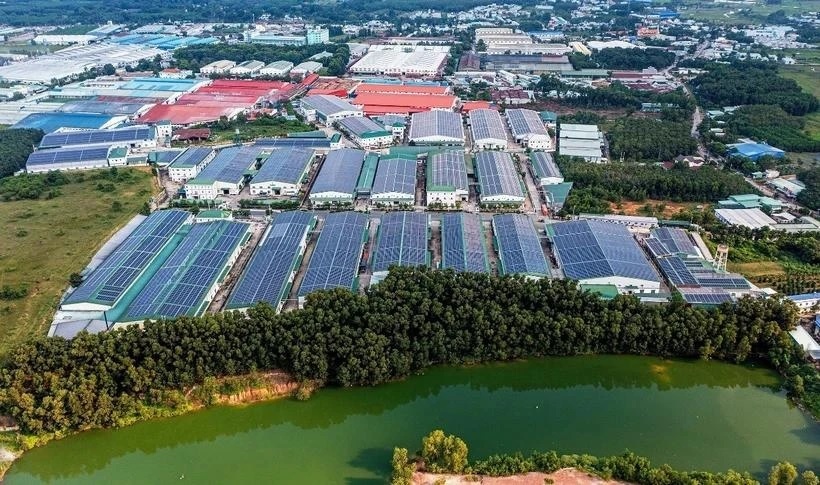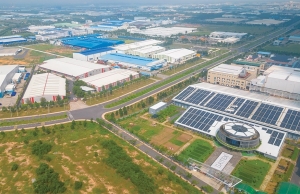North’s industrial property impresses
 |
| Factories in Tan Uyen city, the southern province of Binh Duong (Photo: VNA) |
According to the Industrial Insider 2024 released by Savills Vietnam in November, the manufacturing sector accounted for 48 per cent of the total newly registered foreign direct investment (FDI) for the first nine months in the northern region, focusing on high-value industries such as vehicles and electronics.
The north attracted seven of the 10 corporations in the semiconductor sector. Bac Ninh province leads with four: Samsung Electronics, Amkor Technology, Hanmi Semiconductor, and Victory Giang.
Big names such as Samsung, Foxconn, and Intel have established Vietnam as a leader in electronics manufacturing. Additionally, prominent Chinese electronics brands, including TCL, Haier, and Midea have expanded operations in the country, specifically in the north, bringing high-quality products to market while stimulating local supply chains.
Thomas Rooney, senior manager of Savills Hanoi’s Industrial Services, said that the southern provinces mainly attracted tenants from processing industries such as rubber, plastics, food and beverage, while the north has become a hub of high value-added industries.
“With the goal of positioning Vietnam as a high-tech manufacturing centre, the north is said to have greater resilience and become an attractive destination for investors. This provides momentum for industrial development,” Rooney said.
Under the incoming US administration, experts believe Vietnam’s strategic position, resilient foreign investment flows, and role in supply chain diversification offer significant opportunities for economic growth.
Koh Eng Meng, deputy director of Investment and Asset Management of KTG Industrial, highlighted Vietnam’s strategic advantage in Southeast Asia, noting that the country has largely avoided the harshest penalties impacting Chinese exports.
“Vietnam’s minor trade deficits with the US and its favourable position in Southeast Asia make it an essential destination for foreign investment, especially northern areas not far from China,” he said.
Such positioning is supported by data from S&P Global Market Intelligence, which identifies Vietnam as a top reshoring destination, even surpassing Mexico. A report released in September highlighted Vietnam’s significant growth in reshoring-related sales, driven by domestic demand and exports. This aligns with the China+1 strategy, as companies diversify production to mitigate geopolitical risks, with Vietnam emerging as a top choice.
Typically industrial property areas in Vietnam are heading the charts in FDI results. Bac Ninh is the leading province with 16.2 per cent of total FDI, equivalent to just over $5 billion, tripling last year’s figure, followed by Quang Ninh with $2.23 billion, Ho Chi Minh City $2.28 billion, Haiphong $2.15 billion, and Hanoi $2.06 billion.
Savills said the northern provinces have advantages in abundant land and reasonable rents. In the first half of 2024, northern economic zones provided almost 13,000 ha of industrial land in 73 industrial parks, up 12 per cent over the previous year thanks to the expansion of parks in Haiphong, Hung Yen, and Hai Duong.
Moreover, the industrial land rental price in the north is 28 per cent lower than in the south. Northern provinces have an average occupancy rate of 78 per cent, with an average land price of $132 per sq.m.
 | Savills publishes annual whitepaper on industrial real estate sector Savills Vietnam has released its annual November whitepaper, ‘Industrial Insider 2024: New Wave.’ John Campbell, director and head of Industrial Services at Savills, provided an in-depth analysis of the key trends influencing Vietnam's industrial sector in an interview with VIR’s Bich Ngoc. |
 | Country keeps pace with modern industrial property The industrial real estate market saw increased backing by domestic and foreign investors this past year, creating the foundations for a strong 12 months ahead. |
What the stars mean:
★ Poor ★ ★ Promising ★★★ Good ★★★★ Very good ★★★★★ Exceptional
Related Contents
Latest News
More News
- Green finance offers 'passport' for Vietnamese construction, building materials firms (December 15, 2025 | 08:00)
- Gamuda Land commit long-term investment (December 12, 2025 | 11:49)
- HITC ties up with Evolution to develop AI and hyperscale data centres in Vietnam (December 11, 2025 | 12:09)
- Real estate deals boom via high-profile names (December 08, 2025 | 11:32)
- Industrial segment shaped by M&As (December 08, 2025 | 08:00)
- The Privé sets the benchmark for luxury real estate (December 05, 2025 | 08:28)
- TD CASA and the rise of bespoke interior design in luxury living spaces (December 03, 2025 | 14:14)
- Lee Soo-man's Blooming Sky to build Gia Lai culture, sport, and entertainment complex (December 02, 2025 | 16:41)
- Sustainability in DNA of Keppel Vietnam's future urban development strategy (November 28, 2025 | 10:53)
- South Korean investors seek clarity on IP lease extensions (November 24, 2025 | 17:48)

 Tag:
Tag:





















 Mobile Version
Mobile Version